Seoul Metropolitan Subway rolling stock
There are many types of trains in Seoul but they are usually similar to each other. Typically, train cars have four doors on each side. In between the doors are rows of either cushioned or non-cushioned seats for 7 people, except for the outer ends of each wagon where there are smaller rows of seats for 3 people, marked for the use by the elderly, disabled passengers, and pregnant women.
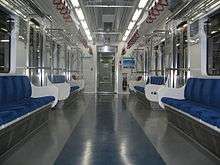
This list focuses primarily on trains that run on the 9 urban subway lines in Seoul, the wide-area commuter rail lines integrated into the Seoul Metropolitan Subway, and the AREX airport railroad. The list does not, however, include rolling stock used on the Incheon Subway and light metro systems such as the U Line or EverLine.
Features
Emergency procedures

Each train has at least one fire extinguisher and options for opening the door in an emergency. A SOS phone is placed in most cars operated by the Seoul Metropolitan Rapid Transit Corporation, and all new rolling stock.
Help for English Speakers

All trains in Seoul have both English and Korean announcements regarding each train stop. In addition, a map displays their names in both Korean and English characters. Many trains also have a LED display above a door or in the middle of the train car that displays information in Korean and English, though many side signs have been removed from trains due to their reduced visibility with the advent of platform screen doors. Some of the newest trains feature LCD screens above the doors or the middle of the train that display short commercials and station information.
Fleet
Seoul Metro/(former) SMRT & Korail
All trains are 19.6 meters in length, 3.12 meters in width, and 3.8 meters in height. Newer trains operated by Seoul Metro are usually given the same number as the trains they are intended to replace.
All trains on Lines 5-8 are equipped with an ATO (Automatic Train Operation) systems. However, there is always a driver on board in case of a failure in the ATO system.
Active (built until 2000)
| Series | Operator | Year Built and Builder |
Photo | Numbers & Total Ordered | Control | Assigned Services | Yard Assignment |
Notes |
|---|---|---|---|---|---|---|---|---|
| Seoul Metro 1000-series (first generation, newer cars) |
Seoul Metro | 1989/1999/2004 (rebuilt 1999 & 2002) Daewoo Heavy Industries, Hyundai Precision & Industries Corporation, Hyundai Rotem |
 |
1-11~1-16 (6 trains, 60 cars) |
Rheostat | Gunja |
| |
| Wide-width car (second batch) | 1989–1993 Daewoo Heavy Industries |
.jpg) _arriving_at_Oksu.jpg) |
Line 2: 2-78~2-92 Line 3: 3-34~3-35, 3-45~3-48 (21 trains, 210 cars) |
Chopper | Line 2: Gunja Line 3: Suseo |
| ||
| 1990–1993 (rebuilt 2010) Daewoo Heavy Industries |
_leaving_Oksu.jpg) |
3-16~3-20, 3-41~3-44 (9 trains, 90 cars) |
Jichuk & Suseo |
| ||||
| Seoul Metro 2000-series (first generation, newer cars) |
1991–1993 (rebuilt 2007–2008) Daewoo Heavy Industries, Hyundai Precision & Industries Corporation, Hanjin Heavy Industries |
.jpg) .jpg) |
2-32~2-39, 2-73~2-77 (13 trains, 130 cars) |
Sinjeong (trains 2-32~2-39) Gunja (trains 2-73~2-77) |
| |||
| Seoul Metro 2000-series (first generation, newer cars, rheostat) |
1990, 1993 (rebuilt 2005) Hanjin Heavy Industries |
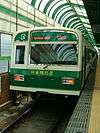 |
2-45~2-48, 2-56 (5 trains, 28 cars) |
Rheostat | Sinjeong (2-45~2-48) Gunja (2-56) |
| ||
| Seoul Metro 2000-series (second generation) |
1993–1994 Daewoo Heavy Industries, Hyundai Precision & Industries Corporation, Hanjin Heavy Industries |
 |
2-14, 2-93~2-95 (4 trains, 40 cars) |
Chopper | Sinjeong & Gunja |
| ||
| Seoul Metro 4000-series | 1993–1994 Hyundai Precision & Industries Corporation (1st batch), Daewoo Heavy Industries (2nd batch) |
 |
4-01~4-26, 4-51~4-71 (47 trains, 470 cars) |
VVVF inverter (GTO) | Chang-dong |
| ||
| Korail Class 341000 (first generation) |
Korail | 1993, 1996 Daewoo Heavy Industries, Hyundai Precision & Industries Corporation, Hanjin Heavy Industries |
 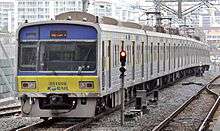 |
341-01~341-25 (25 trains, 250 cars) |
Ansan & Siheung |
| ||
| Korail Class 351000 (first generation) |
1993, 1996, 1999 Daewoo Heavy Industries, Hyundai Precision & Industries Corporation |
351-01~351-22 (22 trains, 132 cars) |
Bundang | Bundang |
| |||
| Seoul Metro 5000-series (first generation) |
Seoul Metro | 1994-1997 Hyundai Precision & Industries Corporation |
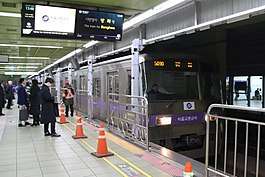 |
5-01~5-76 (76 trains, 608 cars) |
VVVF inverter (GTO) | Banghwa & Godeok |
| |
| Seoul Metro 7000/8000-series (first generation) |
1995-1996 Daewoo Heavy Industries |
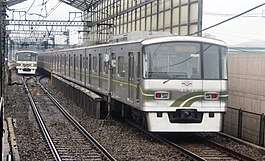 |
Line 7: 7-01~7-17 Line 8: 8-01~8-15 (32 trains, 226 cars) |
Line 7: Dobong Line 8: Moran |
||||
| Korail 3000-series | Korail | 1995–1997 Hyundai Precision & Industries Corporation |
 |
3-71~3-86 (16 trains, 160 cars) |
Jichuk |
| ||
| Korail Class 311000 (first generation) |
1996–1998 Daewoo Heavy Industries, Hyundai Precision & Industries Corporation |
 |
311-01~311-41 (41 trains, 405 cars) |
Guro & Imun |
| |||
| Seoul Metro 1000-series (second generation) |
Seoul Metro | 1998–1999, 2002 Hyundai Precision & Industries Corporation (1st batch), Rotem (2nd batch) |
 |
1-01~1-10 (10 trains, 92 cars) |
Gunja |
| ||
| Korail Class 341000 (second generation) |
Korail | 1999 KOROS |
 |
341-26~341-30 (5 trains, 50 cars) |
Ansan & Siheung |
| ||
| Seoul Metro 6000-series | Seoul Metro | 1999-2000 Hyundai Precision & Industries Corporation, KOROS |
6-01~6-41 (41 trains, 328 cars) |
VVVF inverter (IGBT) | Line 6: Sinnae Line 7: Dobong |
| ||
| Seoul Metro 7000/8000-series (second generation) |
1999-2000 Hanjin Heavy Industries, KOROS |
 |
Line 7: 7-18~7-63 Line 8: 8-16~8-20 (originally 76 trains, 608 cars) |
Line 7: Dobong & Cheonwang Line 8: Moran |
|
Active (built after 2000)
All trains use VVVF inverter-based propulsion systems. Older trains generally use GTO systems, while newer trains generally use IGBT systems.
| Series | Operator | Year Built and Builder |
Photo | Numbers & Total Ordered | Assigned Services | Yard Assignment |
Notes |
|---|---|---|---|---|---|---|---|
| Korail Class 311000 (second generation) |
Korail | 2002–2004 Hyundai Precision & Industries Corporation, Rotem |
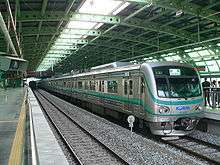 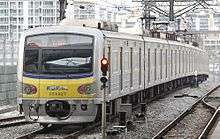 |
311-42~311-65 (24 trains, 240 cars) |
Guro & Byeongjeom |
| |
| Korail Class 351000 (second generation) |
351-23~351-28 (6 trains, 36 cars) |
Bundang | Bundang |
| |||
| Seoul Metro 2000-series (third generation, first batch) |
Seoul Metro | 2005 Hyundai Rotem |
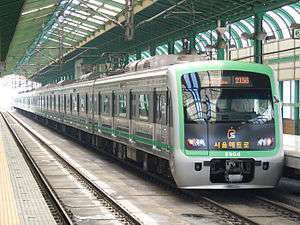 |
2-01~2-05, 2-57 (6 trains, 54 cars) |
Sinjeong & Gunja |
| |
| Korail Class 311000 (third generation, first batch) |
Korail | 2005–2006 Rotem |
  |
311-66~311-82 (17 trains, 170 cars) |
Guro, Byeongjeom, Imun |
| |
| Korail Class 319000 | 2006/1997 Hyundai Rotem (rebuilder) |
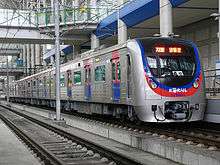 |
319-01~319-07 (7 trains, 28 cars) |
Guro |
| ||
| Seoul Metro 2000-series (third generation, second batch) | Seoul Metro | 2007–2008 Hyundai Rotem |
.jpg) |
2-15~2-31, 2-58~2-72 (32 trains, 298 cars) |
Sinjeong & Gunja |
| |
| Korail Class 321000 | Korail | 2006, 2008–2009 Rotem, Hyundai Rotem |
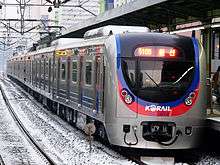 |
321-01~321-21 (21 trains, 168 cars) |
Gyeongui–Jungang | Yongmun |
|
| Korail Class 331000 (first generation) |
2009 Hyundai Rotem |
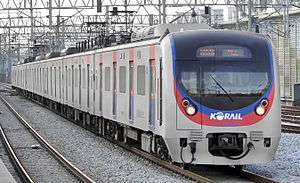 |
331-01~331-13 (13 trains, 104 cars) |
Gyeongui–Jungang | Munsan | ||
| Seoul Metro 3000-series (second generation) |
Seoul Metro | 2009–2010 Hyundai Rotem |
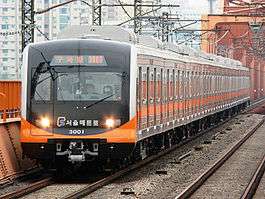 |
3-01~3-33, 3-36~3-40, 3-49 (39 trains, 390 cars) |
Jichuk & Suseo | ||
| Korail Class 361000 | Korail | 2010 Hyundai Rotem |
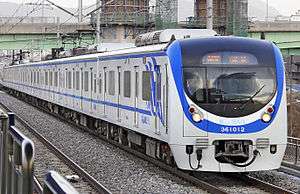 |
361-01~361-14 (14 trains, 112 cars) |
Gyeongchun | Pyeongnae |
|
| Seoul Metro SR-series | Seoul Metro | 2010-2012 Dawonsys |
 |
7-64~7-70 (SR001-SR007) (7 trains, 56 cars) |
Cheonwang | ||
| Korail Class 351000 (third generation, first batch) |
Korail | 2011–2014 Hyundai Rotem |
 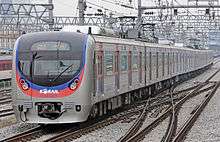 |
351-29~351-43, 351-61~351-72 (27 trains, 162 cars) |
Bundang Suin |
Bundang & Siheung | |
| Korail Class 331000 (second generation) |
331-14~331-27 (14 trains, 66 cars) |
Gyeongui–Jungang | Munsan |
| |||
| Korail Class 311000 (third generation, second batch) |
311-83~311-90, 311-92~311-94 (11 trains, 102 cars) |
Guro |
| ||||
| Korail Class 311000 (third generation, third batch) |
2016–2017 Hyundai Rotem |
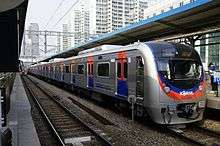 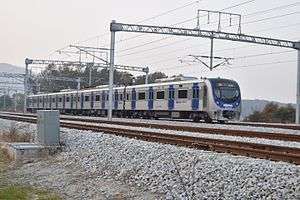 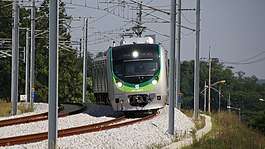 |
311-95~312-03 (9 trains, 90 cars) |
| |||
| Korail Class 371000 | 371-01~371-12 (12 trains, 48 cars) |
Gyeonggang | Bubal | ||||
| Korail Class 381000 (first generation) |
381-01~381-04 (4 trains, 16 cars) |
Gyeongui–Jungang
Korail Donghae (from Busan) |
Bubal | ||||
| Korail Class 351000 (third generation, second batch) |
351-73~351-78 (6 trains, 36 cars) |
Bundang Suin |
Bundang & Siheung | ||||
| Korail Class 391000 | 391-01~391-07 (7 trains, 28 cars) |
Seohae | Siheung | ||||
| Seoul Metro 2000-series (fourth generation) |
Seoul Metro | 2017-2018 Dawonsys |
.jpg) |
2-06~2-13, 2-39~2-42 2-85~2-92 (21 trains, 210 cars) |
Sinjeong & Gunja | ||
| Seoul Metro 5000-series (second generation) |
2017-2018 Hyundai Rotem |
 |
5-77~5-80 (4 trains, 32 cars) |
Godeok | |||
| Korail 341000-series (third generation) |
Korail | 2019- Hyundai Rotem |
 |
341-31~341-37 (7+ trains, 70+ cars) |
Siheung |
| |
| Korail 311000-series (fourth generation) |
 |
312-04-312-07 (4+ trains, 40+ cars) |
Guro | ||||
| Korail 319000-series (second generation) |
319-08~319-10 (3 trains, 18 cars) |
Imun | |||||
| Seoul Metro 2000-series (fifth generation) |
Seoul Metro | 2019- Hyundai Rotem |
.jpg) |
2-14, 2-32~2-38, 2-56, 2-73~2-84, 2-93 (expected) (22 trains, 214 cars) |
Sinjeong & Gunja |
| |
| Seoul Metro 4000-series (second generation) |
4-81~4-85 (expected) (5 trains, 50 cars) |
TBD | |||||
| Seoul Metro 7000-series (fourth generation) |
2020 Dawonsys |
7-71~7-72 (2 trains, 16 cars) |
TBD |
|
Retired
| Model & series number | Operator | Year built and builder |
Photo | Original numbers & total ordered | Assigned services | Year(s) retired | Notes |
|---|---|---|---|---|---|---|---|
| Seoul Metro 1000-series (first generation) |
Seoul Metro Corporation | 1974, 1977–1978 Hitachi |
 |
101/102-119/120 (10 trains) | 1998–1999 |
| |
| 1977–1978 Daewoo Heavy Industries |
121/122-131/132 (16 trains) | 2002 | |||||
| Korail Class 1000 (first generation) |
Korail | 1974, 1976–1981, 1985-1986 Daewoo Heavy Industries, Hyundai Precision, Kawasaki Heavy Industries, Kinki Sharyo, Nippon Sharyo, Tokyu Car Corporation |
 |
1-01~1-41 (41 trains) | 1999–2004 (original cars) 2006 (un-overhauled newer cars) 2012–2014 (overhauled newer cars) |
| |
| Seoul Metro 2000-series (first generation) |
Seoul Metro Corporation, Seoul Metro | 1980–1983, 1986 Daewoo Heavy Industries, Hyundai Precision & Industries Corporation, Hanjin Heavy Industries |
 |
2-01~2-39 2-61~2-75 (see notes) (54 trains) |
2005, 2007–2008 |
| |
| 1989–1990 Hyundai Precision & Industries Corporation, Hanjin Heavy Industries |
 |
2-40~2-52 (13 trains, 130 cars) |
2018–2019 |
| |||
| Wide-width car (first batch) | Seoul Metro Corporation, Seoul Metro | 1984–1985 Daewoo Heavy Industries |
 |
Line 3: 331/332-379/380 Line 4: 401/402~453/454 (52 trains) |
2009–2010 |
| |
| Korail Class 1000 (second generation) |
Korail | 1986–1992 Daewoo Heavy Industries, Hyundai Precision & Industries Corporation, Hanjin Heavy Industries |
 _OC.jpg) |
1-42~1-72 (32 trains, 216 cars) | 2006 (un-overhauled cars) 2012–2017 (overhauled cars) |
| |
| Korail Class 1000 (third generation) |
1994–1997 Daewoo Heavy Industries, Hyundai Precision & Industries Corporation, Hanjin Heavy Industries |
 |
1-74~1-81, 1-83~1-86 (11 trains, 110 cars) |
2015–2020 |
| ||
Seoul Metro Line 9 Corporation (Metro 9)
Seoul Metro (Line 9 Corporation) 9000-series
- First batch (2008) – trains 01~19, 22~24 (6 cars), 20~21 (4 cars each)
- Newer cars for extending trains 01-16 built in 2018.
- Second batch (2011) – trains 25~36 (6 cars each)
- Newer cars for extending trains 29-36 built in 2017.
- Third batch (2016) – trains 37-45 (6 cars each)
- Fourth batch (2019)[5]
 9000-series EMU for Line 9
9000-series EMU for Line 9
NeoTrans Co. Ltd.
Shinbundang Line D000-series (Hyundai Rotem):
- First batch (2010-2011): D01~D12
- Second batch (2014-2015): D13~D20
These trains are controlled by ATO; they are controlled by a computer system on board the train.[6][7]
 D000 series VVVF inverter controlled EMU
D000 series VVVF inverter controlled EMU
Korail Airport Railroad Co., Ltd.
- AREX 1000 series
- VVVF inverter controlled electric car
- AREX 2000 series
- VVVF inverter controlled electric car
 AREX 1000 series
AREX 1000 series AREX 2000 series
AREX 2000 series
See also
References
- 4963 M (28 July 2015). "서울메트로 2호선 239편성 외선순환 열차 건대입구역 출발 (ソウルメトロ2号線旧2000系2039F編成電車)" – via YouTube.
- "교량구간의 교통블로그 : 네이버 블로그". blog.naver.com.
- https://m.blog.naver.com/CommentList.nhn?blogId=aprokdlp&logNo=221815817323
- https://gall.dcinside.com/mgallery/board/view/?id=monorail&no=7039
- http://www.koreatimes.co.kr/www/nation/2018/12/281_259832.html
- "EMUs". Hyundai Rotem. Retrieved 2014-07-29.
- "Railway System". Hyundai Rotem. Retrieved 2014-07-29.